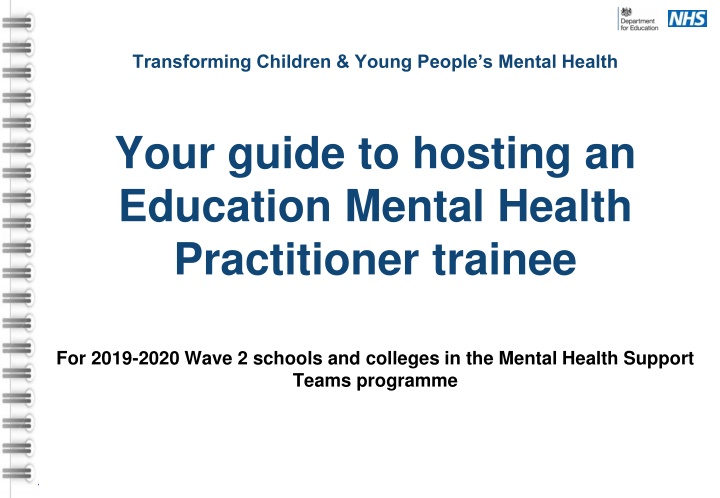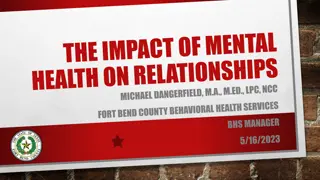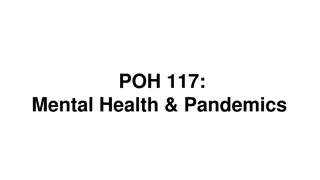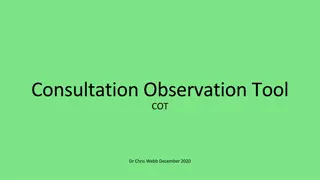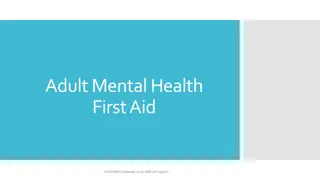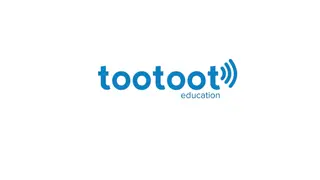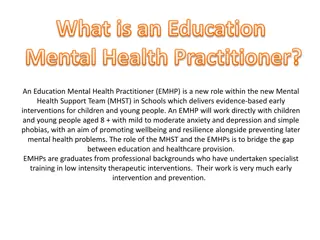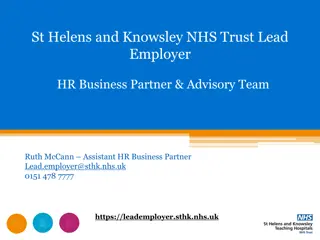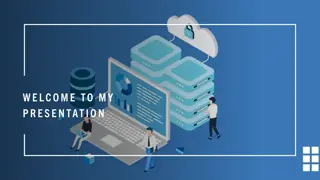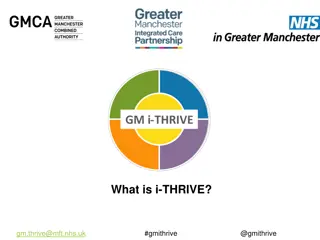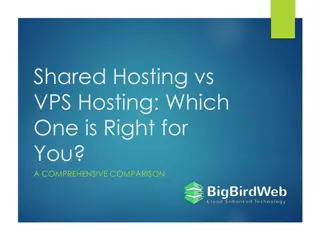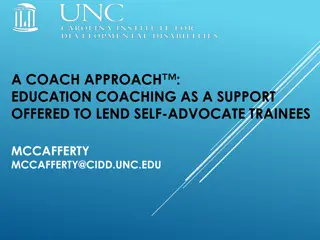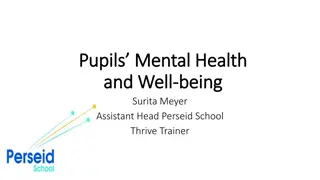Transforming Children & Young People's Mental Health: Guide for Hosting EMHP Trainees in Schools & Colleges
As a participant in the Mental Health Support Team program, this guide outlines the process of hosting Education Mental Health Practitioner trainees at your school or college. It discusses the benefits, roles, and responsibilities associated with supporting the development of EMHPs and shaping mental health services. The document also explains the training program, expectations, and how collaboration between health and education sectors can enhance mental health support for children and young people.
Download Presentation

Please find below an Image/Link to download the presentation.
The content on the website is provided AS IS for your information and personal use only. It may not be sold, licensed, or shared on other websites without obtaining consent from the author.If you encounter any issues during the download, it is possible that the publisher has removed the file from their server.
You are allowed to download the files provided on this website for personal or commercial use, subject to the condition that they are used lawfully. All files are the property of their respective owners.
The content on the website is provided AS IS for your information and personal use only. It may not be sold, licensed, or shared on other websites without obtaining consent from the author.
E N D
Presentation Transcript
Transforming Children & Young Peoples Mental Health Your guide to hosting an Education Mental Health Practitioner trainee For 2019-2020 Wave 2 schools and colleges in the Mental Health Support Teams programme
Introduction Thank you for signing up to work with a Mental Health Support Team (MHST). This pack provides information about being a placement school or college and how you can support the development of Education Mental Health Practitioners (EMHPs), a new role that is being introduced specifically for the MHST programme. Further detailed information about the programme is provided in the 2019-20 Welcome Pack which can be accessed on the FutureNHS Collaboration Platform here. To sign up to the Platform: Email england.cyp-mentalhealth@nhs.netwith the name of your school or college, which trailblazer/MHST site you are linked to, and which year of delivery (2018/19 or Wave 1 or 2 in 2019/20) you are part of. Request access to Collaborative Working in Education Settings and the School and College Information and Resources areas. If you are not a placement school or college but are part of the MHST programme you will receive MHST support once the EMHPs are qualified. The EMHP training programme takes 12 months and therefore support is likely to be offered from Autumn 2020 (Wave 1) or Spring 2021 (Wave 2) although precise timings will be determined in your area. During placement year, prior to becoming fully operational, the MHST will talk to all MHST schools and colleges to identify and discuss your needs. The service will be designed and set up to reflect this including which of the below functions the MHST will focus on. This will be reviewed and monitored regularly.
Being a placement school or college has a number of benefits: Able to offer extra support sooner to intervene early and support pupils or students who present with mild to moderate mental health issues in your school or college The opportunity to help shape a new mental health workforce operating across health and education to support children & young people, their parents/carers and school staff nationwide. Embedding the EMHP in your school or college community before the MHST is fully operational and helping shape the service they provide for your school or college Helping you to develop your school or college s Whole School Approach to mental health and wellbeing earlier, including promoting positive mental health and supporting teachers to deal or respond to mental health issues more effectively Promoting closer partnerships with your community's NHS services and Higher Education Institutions (HEIs) that will be training the EMHPs
Who are trainee Education Mental Health Practitioners? EMHPs are a brand-new addition to the Children and Young People s workforce and will be part of the workforce of the Mental Health Support Team. 19 - 20 Wave 2 EMHP trainees started a 12-month training programme in early 2020, split between classroom theory and practice placements in schools and colleges. During their training year, EMHPs will be required to complete placements across a number of schools and colleges in their local area to ensure they are equipped and experienced to work with different types of schools and colleges and children and young people who present with a range of mental health and wellbeing needs. Entry requirements for the course include the ability to work at degree level, or have an equivalent level of relevant experience, with a proven record of previous learning or formal study in child development, wellbeing or mental health. In their training year, EMHPs will be supported by their supervisors to conduct a range of activities in placement schools. A typical MHST structure (team structures will vary locally) MHST service lead typically works with 2 MHSTs What is the EMHPs role within the Mental Health Support Team? There are generally four EMHPs in each team, with the remainder of the team consisting of senior mental health clinician (supervisors) see slide 15, an MHST manager and administrative support. MHST Senior clinician (Supervisor) Senior clinician (Supervisor) Senior Clinician (Supervisor) EMHP EMHP EMHP EMHP
What are Education Mental Health Practitioners trained to do? Work across education and healthcare to provide early intervention mental health support for children and young people in schools and colleges. To help support schools and colleges to identify and manage issues relating to mental health and wellbeing as well as delivering high quality evidence-based interventions for children and young people experiencing mild and moderate needs and referring onto specialist support, as necessary. The EMHP training course consists of the following six modules: Children & Young People s Mental Health Settings: Context and Values Assessment & Engagement Evidence based interventions for common mental health problems with children and young people (Theory and Skills) Working, assessing and engaging in education settings Common Problems and Processes in education settings Interventions for emerging mental health difficulties in education settings For an overview of the EMHP training, click here. The full course content can be found on the Collaboration Platform. To note: During training, the EMHPs assessments in modules 2 and 3 will involve a video recording of an intervention with a young person, which will need to be shared with the HEI providing the training (please see slide 17 for further information on data sharing agreements)
What is a placement school or college? A placement school or college: - Provides practical experiences for an EMHP(s) over 9 10 months. Placements are a vital element of EMHP training, enabling individuals to gain the necessary experience to complete their course prior to becoming fully qualified. - Identifies opportunities for EMHP(s) to deliver a range of evidence-based group and individual interventions for children and young people with mild to moderate mental health needs. These will be tailored both to the needs of your school or college and the requirements of the EMHP s University course. - Works together with the MHST and University provider to embed the trainee into their school or college community. To note: The number of EMHP trainees a school or college hosts and the time they spend in each setting will be dependent on a range of factors, including: school or college capacity, local need, the set-up of the individual MHST, university timetables and the number of placement education settings. All MHSTs are expected to take a year to become fully operational to allow for the recruitment and training of the practitioners and other staff. To find out more: The process for identifying placement schools will vary locally. If you are interested in becoming one, please contact your MHST lead about arrangements in your area.
The network supporting MHST implementation Local Authorities (LAs) Voluntary & Community Services Clinical Mental Health Trust Commissioning Groups (CCGs) NHS Services Educational Psychologists partnerships CYP Mental Health Services Education settings senior mental health lead and school or college MHST coordinator Pastoral team Mental Health Support Teams (MHSTs) Department for Education (DfE) Supporting schools and colleges in the programme Heath Education England (HEE) Responsible for commissioning training Each team will work with c.8,000 children across 10-20 schools and colleges School nurses School Counsellors MHST Placement schools and colleges Senior clinician (Supervisor) Senior clinician (Supervisor) Senior clinician (Supervisor) Universities Deliver training provide work- based learning EMHP EMHP EMHP EMHP
What are the roles needed within your school or college? Your school or college will need to assign a lead, or leads, to engage with the MHST and develop your organisation's capability to promote positive mental health. These should be individual(s) who are part of your senior leadership team or have their express endorsement. They should also work closely with the school or college pastoral team, and others (e.g. school nurses, educational psychologists, any counselling or other support provided) so that work with the EMHP builds on wider support already in place. School or college MHST coordinator is the senior point of contact in a school or college for liaising with the MHST. This is primarily a logistical and collaborative role, involving planning for MHST implementation and managing interactions with statutory roles. This could be the same person as the senior mental health lead. The senior mental health lead has the strategic oversight of the whole school/college approach to mental health, to support settings to make best use of existing resources and effort to help improve the wellbeing and mental health of pupils and students. The DfE will be offering training to one person in every school and college to support this role.
What experiences will the EMHP need during their placement? If you agree to be a placement school your MHST lead will work with you to design the specific details of what the placement should involve to reflect the course requirements in your area. As EMHPs will likely be placed across several schools you may be required to provide or support the following: An induction into your school or college (which could include: premises orientation, security passes/codes etc, introduction to key staff and contact details, safeguarding, health and safety and other relevant procedures) Orientation actively help your EMHP s/s integration into your school or college by providing information and guidance on: any specific mental health and wellbeing needs and the existing support available for your pupils/students; the education context and relevant staff roles and contacts within your school or college (including the MHST point of contact, senior mental health lead, pastoral support team, educational psychologist, school nurses or counsellors, voluntary sector providers and administrative staff), build networks and start to develop their and the MHST s role within your setting School level Whole school approach/an audit - an opportunity to support your senior mental health lead to develop or build on their whole school approach. This could be supported by the opportunity for an EMHP toplan and run a psycho-education workshop for your staff Groups The opportunity to conduct an assessment of a child or young person s mental health needs. EMHP's are required to gather video evidence as part of their assessments. The MHST supervisor will provide you with further details. The opportunity to deliver evidence-based group and individual interventions to children and young people with mild moderate mental health needs and/or their parents and carers, tailored to the needs of your school or college. Suitable accommodation will need to be provided for this purpose and it will be necessary to consider how parental consent will be acquired, as and where appropriate, in line with your school s/college s policies see slides 23 and 24. Individual pupils
How I can support an EMHP Trainee? From January 2020 MHST leads identify placement school or college and agree induction plans Late February - March EMHP placements start 6-8 weeks after their training commences January 2021 EMHPs qualify and the MHST starts to provide the service in all MHST schools or colleges January 2020 Wave 2 19-20 EMHP trainees begin their training course Actions: Identify an MHST coordinator Actions: Consider and start to identify potential pupils or students who could be referred to the EMHP trainee; and appropriate accommodation space for them to work in (see slides 23 and 24) Help EMHP feel welcome and become embedded into your school community, for example: invite them to a staff briefing send an introductory email with their photo to the staff body provide the trainee with a secure storage space ensure the trainee is aware of key members of staff Notify school or college staff and wider school community about the MHST and EMHP trainees Agree a process for identifying and referring children and young people appropriate for the EMHP trainee to work with See slide 17 and 18 for the full checklist Work with MHST lead/supervisor and HEI to ensure an EMHP induction plan is in place Ensure feedback loop is in place between your school or college, the MHST lead and supervisor while the EMHP is on placement Work with the MHST to complete an audit of mental health and wellbeing provision currently in your school or college
What an EMHP and schools say I recently qualified as an Education Mental Health Practitioner (EMHP), one of the first EMHPs to be trained across the country. During training, my week was split between study with University College of London via the Anna Freud Centre and placement days with my MHST site in West London. During my time on placement I learnt that every education setting is different. I was trained in the delivery of a range of interventions and through collaborating with schools and colleges to try different ways of working and identify appropriate cases, I was able to meet course requirements and gain understanding of what works in each setting. Now qualified, I am using this knowledge to develop individualised programmes of delivery, to meet the needs of the school or college community in a holistic way." Merry Wright, Education Mental Health Practitioner, West London Trailblazer Read Merry s full blog here. As a placement school we are hosting 3 trainee EMHPs, who have felt like an integral part of our team from the beginning. To ensure a successful placement experience a group induction session was held to familiarise the team with our setting, processes and procedures and to meet key members of staff. The EMHPs trainees have so far delivered 1-2-1 interventions, staff training and a group worry workshop from which we have received very positive feedback from young people and teaching staff. They are playing a very active role in driving mental health support forward at Toot Hill School and College." Having the Trailblazer Team in college has already helped us tremendously, in reaching students who although reporting less severe problems/issues/difficulties, to ensure that these problems are dealt with at source and stop them developing into harder, deeper concerns. St Charles Sixth Form College, West London, where Merry Wright is delivering one-to-one interventions with adolescents Toot Hill, Nottinghamshire, 18-19 MHST trailblazer placement school
MHST support in your school or college during the EMHP placement year During their placement year EMHPs will be training, which includes learning the interventions they will be delivering once the MHST is a fully operational and live service. To complete their course EMHPs need to gain specific practical experience, with the days they can spend in schools/colleges to achieve this increasing each term. A key part of this placement is the support EMHPs will need from the school/college MHST coordinator to access appropriate referrals/work needed to pass the course, as well as supporting them in managing others expectations of their work and possible requests to undertake work that is outside this stage of their training. Your MHST will talk to you about what is involved, the service you can expect during this training year, your school s/college s specific needs and how the MHST might be able to help. The wider MHST team can also help in considering other options for support where there are higher priority MH needs or pupils within the schools/colleges who the trainee EMHPs are unable to see. What support to expect during placement year After a period of induction in your school or college and as their university course progresses, EMHPs will begin to conduct interventions with children and young people (with appropriate support from their supervisor) EMHPs are in training and will therefore have a smaller case load of children and young people than when the MHST is fully operational (please clarify what this will look like in practice with your MHST Team Manager, as case loads will vary locally) You will need to work with your MHST project lead to agree a process for referral of appropriate cases The MHST, when EMHPs are fully trained, has 3 core functions 1. Delivering evidence-based interventions for mild to moderate mental health issues The new teams will carry out interventions alongside established provision such as counselling, educational psychologists, and school nurses building on the menu of support already available and not replacing it. The MHST will provide: Individual face-to-face work: for example, effective, brief, low-intensity interventions for children, young people and families experiencing anxiety, low mood, friendship or behavioural difficulties, based on up to date evidence. Group work for pupils or parents such as Cognitive Behavioural Therapy for young people for conditions such as anxiety. Group parenting classes to include issues around conduct disorder and communication difficulties.
MHST support in your school or college during the EMHP placement year 2. Supporting the senior mental health lead in each school or college to introduce or develop their whole school or college approach: Work with the senior mental health lead and existing service providers, to map what provision is already in place in settings and where the gaps are. Provide targeted help as agreed with the lead, e.g. to support monitoring of well-being across the schools and colleges, teaching about mental health as appropriate. EMHP supervisory support within your school or college: The work of EMHPs will be supervised closely during their placement year. Referrals and external services are likely to be managed by the MHST supervisors or a senior member of staff. Where a child or young person falls outside of the mild-to- moderate EMHP remit, the EMHP will work with their MHST supervisor to appropriately signpost or refer on to local services. What support to expect during placement year: Trainees will need to evidence their contribution to whole school working in schools and colleges, including: Supporting peer mentoring, providing staff training or running a psycho-education workshop Conducting group work (with children and young people or parents) or providing a piece of consultation work EMHPs will be supported by senior staff to provide targeted help 3. Giving timely advice to school and college staff, and liaising with external specialist services, to help children and young people to get the right support and stay in education: Work as part of an integrated referral system with community services to ensure that children and young people who need it receive appropriate support as quickly as possible. External support could include more specialist NHS mental health support, support for autism spectrum disorder, learning difficulties or physical needs, or for issues such as substance misuse. Ensure smooth transition from specialist services.
What support can a fully trained EMHP provide in your school or college? An example guide from CYP IAPT Midlands Collaborative. Regional variations may occur; please confirm list with your HEI or EMHP Supervisor. EMHPs MAY Do EMHPs MAY Do EMHPs SHOULD NOT DO EMHPs SHOULD NOT DO Significant levels of need /complex conditions EMHPs Can Do EMHPs Can Do Discretion and close supervision. Behavioural difficulties Behavioural difficulties identification, identification,brief parenting support brief parenting support Support staff and help cofacilitate a full parenting Support staff and help cofacilitate a full parenting programme such as Triple P programme such as Triple P Conduct disorder, anger management, full parenting Conduct disorder, anger management, full parenting programmes (e.g. Triple P, Solihull Approach). programmes (e.g. Triple P, Solihull Approach). Training parents and teachers to support Training parents and teachers to support interventions with children interventions with children Irritability as a symptom of depression Irritability as a symptom of depression (can (canpresent as present as Treatment of parents depression and anxiety. Treatment of parents depression and anxiety. anger) anger) Low confidence, Assertiveness or interpersonal Low confidence, Assertiveness or interpersonal challenges challenges e.g. with peers e.g. with peers Some short Some short- -term phobia exposure work term phobia exposure work Low mood Low mood Anger management training, Chronic depression Anger management training, Chronic depression Worry management Worry management Anxiety/Avoidance: Anxiety/Avoidance: e.g. simple phobias, separation anxiety e.g. simple phobias, separation anxiety Low self Low self- -esteem, social anxiety disorder esteem, social anxiety disorder S Some short ome short- -term phobia exposure work term phobia exposure work Extensive phobias e.g. Blood, needles, or vomit phobia Extensive phobias e.g. Blood, needles, or vomit phobia Thoughts of self Thoughts of self- -harm, superficial self harm, superficial self- -harm. Basic harm reduction techniques reduction techniques harm. Basic harm Panic Management Panic Management Severe, active, high risk self Severe, active, high risk self- - harm. harm. Assessing self Assessing self- -harm and supporting with harm and supporting with alternative coping strategies. Pupils with alternative coping strategies. Pupils with history of self history of self- -harm, but not active. harm, but not active. Insomnia (further training may be required) Insomnia (further training may be required) PTSD, trauma, nightmares PTSD, trauma, nightmares Relationship problems Relationship problems - -counselling for issues such as counselling for issues such as relationship problems may be better suited to school relationship problems may be better suited to school counsellors. counsellors. Sleep Hygiene Sleep Hygiene Assessment of complex interpersonal challenges Assessment of complex interpersonal challenges Thought Challenging Thought Challenging negative automatic thoughts thoughts negative automatic Mild/early onset Obsessive Compulsive Disorder (OCD) Mild/early onset Obsessive Compulsive Disorder (OCD) (further training may be required) (further training may be required) Obsessive compulsive disorder moderate to severe in nature Obsessive compulsive disorder moderate to severe in nature Children that are displaying rigid, ritualistic behaviour Children that are displaying rigid, ritualistic behaviour that may or may not be within a diagnosis of ASD that may or may not be within a diagnosis of ASD Moderate to severe attachment disorders. Assessment and Moderate to severe attachment disorders. Assessment and diagnosis of developmental disorders and learning difficulties. diagnosis of developmental disorders and learning difficulties. Problem Solving Problem Solving Pain management Pain management Historical or current experiences of abuse or violence Historical or current experiences of abuse or violence
What is the role of the EMHP senior mental health clinicians (supervisors)? Each team will have senior mental health clinicians who are experienced mental health professionals, ideally with experience of delivering and supervising mental health approaches in education settings. They will have a minimum of 2- 4 years working therapeutically within a children and young people mental health setting. Ideally, they will also have experience of delivering and supervising mental health approaches in education settings and experience of delivering Cognitive Behavioural Therapy (CBT) informed supervision as well as practice related to schools and colleges. They will supervise the EMHPs practice of low intensity cognitive behaviour interventions and provide advice on the whole school and college approaches to mental health. They will have existing knowledge and competencies in both areas. The supervisor will also have their own small case load, conduct assessments for more complex cases and leading consultation meetings with settings amongst other responsibilities depending on their role. A typical MHST structure (team structures will vary locally) The supervisor will be responsible for signing off the EMHP trainees learning objectives and competencies. They will receive specific training to equip them in their role as an EMHP supervisor. MHST Senior clinician (Supervisor) Senior clinician (Supervisor) Senior Clinician (Supervisor) The EMHPs will receive appropriate levels of supervision and support on all their cases. EMHP EMHP EMHP EMHP During initial conversations with the MHST lead the school or college MHST coordinator will discuss the role of the supervisor and the level of engagement they will have directly with your school or college. The EMHP supervisor is most likely to work with and support your MHST coordinator to set up this service.
In preparation for your Education Mental Health Practitioner trainee you should: Communication and raising awareness: Understand the scope of the EMHP trainee remit and their role during their training year and help other school/college staff to do the same see slides 4, 5, 12 and 13. Ensure your wider school or college community is aware that you will be hosting a trainee EMHP and what a Mental Health Support Team is, including both their work and the principles and aims of the Government s Green Paper. Ensure you have established a feedback loop between the EMHP, your school/college and the MHST. Setting up processes and joint ways of working: Consider which pupils/students may be suitable for EMHP trainee interventions. Work with the MHST Lead to set up a process for identifying and referring pupils or students for supervised support by the EMHP and consider how this will fit into your school s policy for gaining parental consent for mental health intervention. Agree with the MHST lead in place protocols for information sharing related to children and young people (including GDPR agreements with NHS services and schools). This may form part of any initial partnership agreement or MoU between the organisations.
In preparation for your Education Mental Health Practitioner trainee you should: Resource: Ensure you have an MHST co-ordinator in place, who has capacity to meet regularly with the EMHP trainees, build close links with the MHST team and academic provider, ensure access to appropriate referrals/work resulting in a quality placement. Provide secure, confidential and permanent physical space to conduct one to one interventions, phone calls and group work, both in and outside of school hours - see slide 23 and 24. Provide secure, lockable storage for sensitive paperwork relating to interventions and group work within your school or college that can always be accessed by EMHPs. Induction: Prepare to embed the EMHP into your school/college community (consider access to printing, a secure and locked space for storing belongings, access to staff room and meetings with key staff members e.g. SENCo, existing pastoral staff, safeguarding leads, PSHE lead, Heads of Year etc).
Frequently asked questions on Education Mental Health Practitioner placements When can EMHP trainees start working with our pupils/students? When an EMHP trainee first arrives at your school or college, it is important to remember that they are there to undertake work-based learning and may not be fully equipped to start working with pupils/students straight away. The experience of EMHP trainees is likely to vary, and it is important to build in a short induction period to introduce your trainee to all relevant school and college policies and procedures, key personnel and discuss their learning and development goals. The precise timing will be agreed prior to the trainee starting their placement by the senior clinician or MHST lead. When they start working with pupils/ students they will do so with appropriate supervision. How can we identify pupils/students who might have mild to moderate mental health difficulties? Your MHST will discuss this with you and provide advice to help you do this. It is important that you agree a referral process for children and young people to receive support from the MHST. Slide 14 sets out some of the issues the EMHP will deal with but is an example and not exhaustive. What assistance can we offer children who don t qualify for direct support from the MHST? One of the key functions of the MHST is to ensure children and young people receive appropriate support from the right service, this might be a specialist service offering higher intensity interventions or a community-based service that may or may not be delivered by health services. Staff in the MHST should be able to help identify a clear pathway to the most appropriate services to meet identified needs.
Frequently asked questions on Education Mental Health Practitioner placements continued Under what circumstances will EMHPs/MHSTs require parental consent and what parts of the EMHP/MHST s service will not require consent? Where a referral is made for a particular intervention offered by the team, engagement with parents and carers in relation to the intervention will be governed by the MHST team s operating protocols. MHSTs will need to work with the school or college to ensure that parents and carers are aware of their services and they know how they can be involved, clarifying where they will and won t be consulted. Schools and colleges and MHSTs will also need to consider whether and how to enable referrals for support by parents, how to involve them in the design of services, whether they are able to involve them in the delivery or receipt of interventions and to what extent they need to give consent for interventions. MHSTs should also consider the Gillick competency and Fraser guidelines when considering how best to engage with parents and carers in their child and young person s care. This will allow them to balance the need to listen to the child s wishes whilst balancing the responsibility to keep them safe. What information will the EMHP trainees/ MHSTs collect and share on the pupils/students you work with and why? MHSTs will be recording data on the service they deliver and the outcomes of individual interventions. If you wish to find out more please talk to your MHST lead. What can/should the senior mental health clinicians in the MHST team be doing? This is a decision for the MHST and will vary locally, but it is useful for supervisors to model the same interventions EMHPs will carry out. They may also provide case consultation for complex cases with, or offer training for, school or college staff, or work with children and young people with slightly more complex additional needs (e.g. in special schools or in alternative provision).
Where to go for further support I have a question about the MHST set up and service/my EMHP trainee provides Your first point of contact should be your Mental Health Support Team Manager as they will be the day-to-day manager of the MHST. They will also be in contact with the universities who are training the Education Mental Health Practitioners. Note the details of your MHST Manager here: I would like advice about education involvement in the programme There is a Department for Education Regional Lead and Deputy Regional Lead for each region across England. If you would like further information about them, or general education involvement, please email the Regional team mailbox. Regional team mailbox: MHGP.DELIVERY@education.gov.uk MHGP.DELIVERY@education.gov.uk MHGP.DELIVERY@education.gov.uk Checklist I want to talk to other people from my region who are involved/I want to see further advice and guidance Go to the NHSFutures Collaboration Platform (for how to sign up see slide 2)
What is a suitable accommodation space? An example guide from CYP IAPT Midlands Collaborative Minimum Mental Health Support Teams Therapeutic Room Requirements Minimum Mental Health Support Teams Therapeutic Room Requirements Assuming Educational Mental Health Practitioners (EMHPs) will bring all their own equipment and mobile way of securely storing notes Why is such a space required? Why is such a space required? Consider the type of issues discussed in these sessions. They will be personal and often difficult. These sessions are very different from a music or other out of class lesson. The child or young person must feel able to trust the practitioner, to build a relationship in a secure and confidential setting or the impact of such work will be drastically reduced or even completely stopped. It might help to consider if you were going to discuss why you are feeling low, upset or behaving badly with a stranger what sort of place would you want? What sort of space would help you establish a good relationship with this person? What sort of place would make you feel unable to talk or feel like you were unimportant? A consistent, calm space, not subject to change, as this is settling to the children and the process. As all rooms will be shared this means a joint agreed presentation and leaving of the room with types of appropriate displays. Not a place used for sanctions. Must not be time out room/ head teacher s office At least 4m x 4m Quiet and private confidential. Not overheard for the duration of the session. Not a corner of the dining room, corridor,storage cupboard, nor open plan space. No interruptions clear, respected signs. Staff made aware of the importance of not interrupting. Input into staff meeting about purpose and use of room. Booking system for medium term advance booking that will not be overridden. Covering for any windows e.g. paper, although a blind would be preferential Heating (when cold), lighting, ventilation provision for when its hot 2 chairs or seating for 6 if group work required (foldable chairs stored for use?) Table for writing/drawing exercises.
What is a suitable accommodation space? An example guide from CYP IAPT Midlands Collaborative School requirements Agreement on procedure in case of difficult situation e.g. room being used/ not suitable Cancellation of room if not required by EMHP Agreement to leave room as found it by EMHP/ MHST IDEAL Mental Health Support Teams Therapeutic Room Requirements IDEAL Mental Health Support Teams Therapeutic Room Requirements As the minimum requirements plus As the minimum requirements plus Comfortable seating for several people Daylight with blinds Soundproofed Used only for similar, positive work. Pleasant, relaxing, soothing surroundings such as pictures of the natural world, age appropriate stress toys, plants. Box of tissues. Pens/pencils and paper Whiteboard with pens A space (can be staff room or other flexible space) with power socket for EMHP to type up notes
